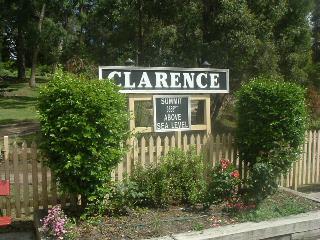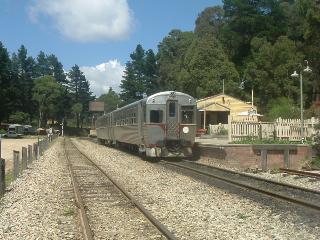Clarence, NSW. 12th December, 2007.
If you’re travelling to the Zig Zag Railway from Sydney along the strangely-named ‘Bell’s Line of Road’, you’ll maybe see why the zig zag is necessary. As the road reaches the Blue Mountains, the road climbs the hill gently, before it comes to a vicious hairpin bend, and reverses direction. Maybe, if the road went directly up the hill, a modern car might make it; a car of yesteryear probably wouldn’t. And, certainly not a loaded 18-wheeler, as you’ll probably know if you’ve ever been stuck behind one on a steep slope.
And, if you do your thing in the hills, you’ll see most mountain paths zig zag too, rather than taking the directissima.
This was the problem facing railway engineer John Whitton in 1866. A tunnel through the mountains would have been the ideal way to get his railway west from Sydney, but that was an extensive undertaking and he didn’t have the budget.
So … to paraphrase the old song, can’t go through it; can’t go around it; had to go over it. Trains would climb up to Clarence by the now-defunct Lapstone Zig Zag, and descend to Lithgow by the Lithgow Zig Zag, which still exists, although in a much-altered form. At Lapstone, they had to do little more than lay the track; at Lithgow, viaducts and short tunnels had to be engineered, too.
By 1907, however, traffic on the railway had increased so much that the laborious procedure at Clarence was creating unacceptable bottle-necks, so they decided they could now afford the tunnels to replace it. They completed in 1910; Clarence was by-passed and the Zig Zag Railway fell into disuse.
In 1975, a group of enthusiasts thought that such a fine feat of engineering ought to be preserved, and used for the purpose for which it was intended. So, it was decided to reinstate the railway, using largely volunteer labour. But, probably for reasons of economy, they laid the track to the 3’6″ (‘Country Railway’) gauge, rather than the original ‘Standard’ 4’8½”. Since this gauge was rarely, if ever, used in New South Wales, it meant that locomotives and rolling stock had to come from Queensland and South Australia, where it was more common.
Usually, through the week, or on days of serious fire risk, they run a vintage diesel railcar . But, we visited on a day that a steam loco was running. The coaches came from the Queensland Railway, or so I deduced from the ‘Q.R.’ on the ornate luggage racks. The locomotive was an immaculately preserved, ex-Queensland Railways unit built by Walker’s Limited, of Maryborough, Qld., in 1956.
The round trip takes about 45 minutes, and the engine ‘runs around’ at the Top Points and Bottom Points station; passengers are welcome to dismount for photography, or just to stretch their legs. If you’re lucky, and can come when two trains are running, you can photograph the other train, too … preferably, as it toils up the hill.
At the Bottom Points Station, it’s only a short walk to the platform of the main line Sydney-Lithgow railway. If you’re going back to Sydney on the train, the line will pass through the tunnels which replaced the Zig Zag Railway.
But, if you’re going the other way, the line goes beyond Lithgow … and will, eventually, on its way to distant Perth, reach the longest stretch of straight railway track in the world. Truly, a 180-degree contrast to the Lithgow zig zags!
(My picture is of the diesel railcar … there’ll be video of the steam locomotive next week)


[…] The ZigZag Railway By travelrat But, if you’re going the other way, the line goes beyond Lithgow … and will, eventually, on its way to distant Perth, reach the longest stretch of straight railway track in the world. Truly, a 180-degree contrast to the Lithgow zig zags … Travelrat’s Travels – https://travelrat.wordpress.com […]
By: Darling Range Perth Hills Information Directory on March 15, 2008
at 3:57 am
[…] you??ll maybe see why the zig zag is necessary. As the road reaches the Blue Mountains, the road clihttps://travelrat.wordpress.com/2008/03/10/the-zigzag-railway/Rain and delays set for weekend BBC NewsBusy roads and rail delays are expected over the Bank […]
By: railways of south wales on June 1, 2008
at 9:58 am